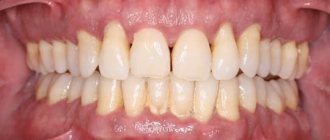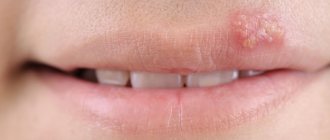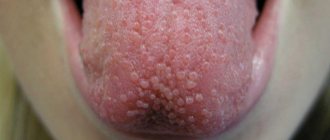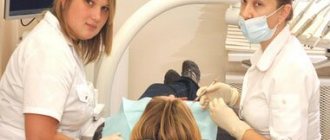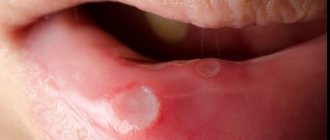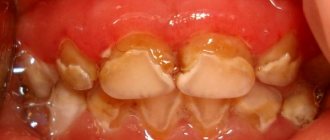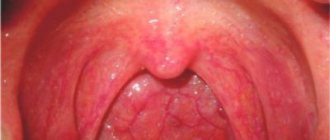Chronic tonsillitis: symptoms and treatment at home
Chronic tonsillitis is an inflammatory process localized in the palatine tonsils, which has taken on a sluggish, protracted form. The form of the disease is characterized by periodic relapses (recurrence at certain intervals in the presence of predisposing factors for acute episodes of the disease).
Considering that we are talking about an important organ that plays a decisive role in the chain of formation of the immune and physiological types of defense of the body, the importance of diagnosis and effective mechanisms for treating pathology among doctors is beyond doubt. This is an article prepared by our specialists based on materials from the work of practicing otolaryngologists.
What it is?
Chronic tonsillitis is a long-term inflammation of the pharyngeal and palatine tonsils (from the Latin tonsollitae - tonsil glands). Develops after a sore throat and other infectious diseases accompanied by inflammation of the mucous membrane of the pharynx (scarlet fever, measles, diphtheria), or without a previous acute illness.
Causes
Factors that contribute to the development of chronic tonsillitis in adults and children:
- allergic rhinitis;
- deviated nasal septum;
- decreased local and general immunity;
- frequent runny nose;
- inflammatory diseases that develop in other ENT organs;
- caries;
- the presence of foci of chronic infection in the human body;
- allergic mood of the body.
Chronic tonsillitis is an infection-dependent inflammatory process that develops as a result of the pathogenic activity of microorganisms. Normally, the tonsils in the body exist to trap infectious agents and prevent them from penetrating deeper into the respiratory tract. If there is a decrease in local or general defenses of the body, then pathogenic microorganisms that linger on the tonsils begin to actively develop and multiply, provoking the progression of the disease.
Symptoms
Chronic tonsillitis in adults occurs with periods of remission and periods of exacerbation. With the development of an exacerbation, signs of tonsillitis (acute tonsillitis) develop:
- a sharp increase in body temperature to febrile levels (39-40 degrees);
- intense sore throat;
- regional lymph nodes enlarge;
- purulent plaque appears on the tonsils;
- There may also be purulent follicles on the mucous membrane of the tonsils.
During the period of remission, the patient may have the following symptoms of chronic tonsillitis:
- discomfort in the throat;
- feeling of a lump in the throat;
- slight pain in the morning;
- bad breath;
- plugs on the tonsils;
- small accumulations of pus in the lacunae.
Also, in addition to the signs of tonsillitis itself, there may be symptoms of concomitant diseases - chronic pharyngitis, rhinitis, sinusitis.
With the development of the decompensated form, the following symptoms appear:
- increased fatigue;
- general malaise;
- headache;
- prolonged low-grade fever (temperature stays around 37 degrees).
In addition, signs of complications may appear. The most common complication in the decompensated form of chronic tonsillitis is a peritonsillar abscess.
It begins as a sore throat, but later the patient cannot swallow or open his mouth at all. There is pronounced swelling of the pharyngeal tissue. The patient requires urgent medical care and hospitalization. Exacerbation of chronic tonsillitis can be triggered by hypothermia, an acute respiratory viral infection, or drinking cold drinks or food.
Forms of the disease
Doctors talk about chronic tonsillitis in cases where the tonsils are constantly in an inflamed state, and there can be 2 options:
- first - tonsillitis seems to completely disappear, but with any hypothermia its symptoms immediately return;
- second - the inflammation practically does not go away, it only subsides, while the patient feels satisfactory, but the doctor sees that the tonsillitis has not disappeared anywhere, but has entered a subacute stage.
In both cases, it is necessary to take measures to achieve long-term (preferably several years) remission.
In medical circles, there are two forms of chronic tonsillitis:
- Compensated. P appears as local signs of chronic inflammation of the tonsils;
- Decompensated form. It is characterized by local symptoms, aggravated by purulent complications in the form of abscesses (encysted purulent foci), phlegmon (diffuse purulent foci), complications of distant organs (kidneys, heart).
It is important to consider that with any form of chronic tonsillitis, the entire body can become infected and an extensive allergic reaction can develop.
Diagnostics
During the examination, the doctor palpates the lymph nodes and examines the tonsils directly. But experts do not limit themselves to this, given how many complications can be caused by this disease. The contents of the lacunae are also sampled and sent for analysis. Taking material for laboratory testing is carried out by pressing on the tonsil, from which pus is released. If the pus has a mucous structure and an unpleasant odor, then most likely there is a chronic form of tonsillitis. But even this analysis cannot show the complete clinical picture and accurately determine the diagnosis.
To make an accurate diagnosis, doctors pay attention to the general condition of the body and the presence of deviations from the norm. Such deviations are primarily considered to be thickened edges of the palatine arches and hyperthermia. Experts also determine cicatricial adhesions between the palatine arches and tonsils.
Tonsils, in the chronic form of tonsillitis, have a loose appearance and a scar-altered surface. In the lacunae of the tonsils there are purulent plugs or purulent discharge.
First signs
Signs of the disease depend on its form - recurrent and sluggish tonsillitis (without exacerbations). Also, chronic tonsillitis can be atypical with a long course, low or low-grade fever and symptoms of intoxication (discomfort in the joints and muscles, nausea and headache). Such a clinical picture in some cases can affect a person’s entry into the army, but only if the disease is extremely severe.
Among the most obvious local signs of the presence of chronic tonsillitis in the body are the following:
- Frequent sore throats, that is, recurrence of the disease more than three times a year;
- Changes in the normal state of the tissues of the tonsils - their increased looseness or compaction, cicatricial changes and other pathological processes.
- The presence of dense purulent “plugs” in the tonsils or the release of liquid pus from the lacunae.
- Sharp redness and increase in volume of the edges of the palatine arches, which visually resembles the formation of ridges.
- The presence of adhesions and scars between the tonsils and palatine arches indicates a long-term inflammatory process.
- Inflammation and enlargement of the submandibular and cervical lymph nodes, accompanied by increased pain (when touched or pressed).
Consequences
When tonsillitis becomes chronic, the body's immune response decreases, which can affect the functioning of internal organs. In severe cases, when symptoms of intoxication appear, some complications develop.
Prolonged infections lead to complications associated with cardiac dysfunction and kidney disease. Often, advanced tonsillitis is accompanied by rheumatism and tonsillocardial syndrome. Serious damage to health is caused by toxins that are released during sore throats.
Complications
With chronic tonsillitis, the tonsils turn from a barrier to the spread of infection into a reservoir containing a large number of microbes and their metabolic products. Infection from affected tonsils can spread throughout the body, causing damage to the heart, kidneys, liver, and joints (associated diseases).
The long course of the disease provokes the appearance of symptoms of infectious complications from other organs and systems:
- diseases with a pathological increase in collagen production - rheumatism, periarteritis nodosa, dermatomyositis, systemic lupus erythematosus, scleroderma;
- skin lesions - eczema, psoriasis, polymorphic exudative erythema;
- nephritis;
- thyrotoxicosis;
- damage to peripheral nerve fibers - radiculitis and plexitis;
- thrombocytopenic purpura;
- hemorrhagic vasculitis.
Treatment of chronic tonsillitis
When treating a compensated form and in the absence of complications, chronic tonsillitis is treated conservatively at home using effective drugs. If the patient has signs of decompensation of chronic tonsillitis and complications develop, then surgical intervention may be required.
First of all, measures are taken to strengthen the body's defenses - proper nutrition, reduction of bad habits. If there are concomitant diseases, which are also sources of constant infection, they need to be cured:
- mandatory sanitation of the oral cavity - treatment of inflammatory diseases (caries, stomatitis);
- treatment of sinusitis, pharyngitis, rhinitis.
How to treat chronic tonsillitis: list of drugs
For the conservative treatment of chronic tonsillitis in adults, the following drugs are used:
- Antibiotics for tonsillitis. This group of drugs is prescribed only in the presence of an exacerbation of chronic tonsillitis; antibiotic therapy is recommended based on tank data. sowing. It is not worth prescribing drugs blindly, as this can cause a lack of effect and loss of time, not to mention side effects and worsening of the condition. Depending on the severity of the inflammatory process in sore throat, the doctor may prescribe a short course of the safest and easiest remedies, since with long courses of strong drugs it is necessary to supplement the treatment with a course of probiotics. In the latent course of chronic tonsillitis, treatment with antimicrobial drugs is not indicated, since this additionally disrupts the microflora of the oral cavity and gastrointestinal tract, and also provokes immune suppression.
- Painkillers. For severe pain, the most optimal is Ibuprofen or Nurofen; they are used as symptomatic therapy and for minor pain their use is not advisable (see the full list and prices of non-steroidal anti-inflammatory drugs in the article Injections for back pain).
- Probiotics. When prescribing aggressive forms of broad-spectrum antibiotics and in the presence of concomitant gastrointestinal pathologies (reflux, colitis, gastritis), before taking antibiotics, it is necessary to take probiotics that are resistant to the action of the former - “Normoflorin”, “Gastrofarm”, “Primadofilus”, “Narine”, "Rela Life", "Acipol".
- Antihistamines. To reduce swelling of the mucous membrane, tonsils, and swelling of the posterior pharyngeal wall, you need to take desensitizing medications; they will also contribute to better absorption of other medications. From this group of drugs, it is better to use the latest generation of drugs, since they have a prolonged effect and do not have a sedative effect, they are safer and stronger. Among the antihistamines, the best are Fexofast, Fexadin, Telfast, Zodak, Letizen, Zirtec, Parlazin, Cetrin.
- Antiseptic local treatment. An important condition for effective treatment is gargling; for this you can use various solutions, either ready-made sprays or dilute special solutions yourself. It is most convenient to use Miramistin (250 rubles), which is sold with a 0.01% solution spray, Octenisept (230-370 rubles), which is diluted with water 1/5, as well as Dioxidin (1% solution 200 rubles 10 ampoules), 1 amp. diluted in 100 ml of warm water (see list of all throat sprays). Aromatherapy can also have a positive effect if you gargle or inhale with essential oils - lavender, tea tree, eucalyptus, cedar.
- Antiseptic local treatment. An important condition for effective therapy is gargling. For these purposes, you can use both ready-made sprays and self-prepared solutions. It is most convenient to use Miramistin 0.01% solution, Octenisept, Dioxylin, which are diluted with warm water. Aromatherapy also has a positive effect if you gargle and inhale with essential oils - cedar, eucalyptus, tea tree, lavender.
- Immunostimulating therapy. Among the drugs that can be used to stimulate local immunity in the oral cavity, perhaps only Imudon is indicated for use, the course of therapy is 10 days (absorbable tablets 4 times a day). Among the products of natural origin, you can use Propolis, Pantocrine, ginseng, and chamomile to boost immunity.
- Emollients. Inflammation in the throat and taking certain medications may cause dry mouth, sore throat, and sore throat; in such cases, it is effective to use sea buckthorn, peach, and apricot oils, provided there is no individual intolerance to them. In order to soften the nasopharynx well, you can instill one of the oils into the nose in the morning and evening, a few drops at a time, during the procedure you should throw your head back. Another method of softening the throat is 3% hydrogen peroxide, which is used to gargle for as long as possible, after which the mouth is rinsed with warm water.
Purulent plugs in chronic tonsillitis
Structure of the tonsils
The palatine tonsils, or tonsils, are an important organ of the human immune system. The tonsils are located in the oral cavity on both sides of the pharynx. The tonsils are shaped like an almond (hence the name “almond”) and range in size from one to four centimeters in diameter. The tonsils are endowed with a protective function. They are a kind of barrier to bacteria entering the body through airborne droplets, as well as through food intake. The structural features of the tonsils and the functions they perform are directly related to the appearance of tonsillitis plugs in the throat.
Make an appointment right now!
Call us by phone or use the feedback form
Sign up
On the surface of the tonsils, winding canals and openings are visible - lacunae and crypts.
When viruses from the outside enter the mouth, leukocytes in the tonsils are activated and begin an intensified process of forming antibodies that fight the “enemy.” At the same time, a signal is sent to all organs of the immune system, and the body comes into “combat readiness”.
Physiotherapeutic methods
Physiotherapeutic treatment of chronic tonsillitis can be effective during remission - laser therapy is recognized as very effective due to its antibacterial and anti-inflammatory effect due to its direct effect on the tonsils. Short-wave UV radiation of the throat and oral cavity is also used.
There are methods of ultrasonic treatment of the tonsils, which act on the source of the disease itself, destroying the structure of the resulting cheesy mass. Using ultrasound, you can also irrigate the tonsils with antiseptic solutions.
An effective remedy is inhalation of wet steam. But there is one contraindication here - high temperature, so the temperature must first be lowered, and only then inhalation. Inhalations can be used using various medicinal herbs - chamomile, calendula, etc., chlorhexidine solution, or you can simply breathe over potatoes. You should not take deep breaths when inhaling, because in the case of tonsillitis, only the inflamed tonsils need to be affected.
Treating tonsillitis at home
Let's look at some of the most interesting recipes for treating tonsillitis at home, which include honey and its derivatives:
- For oral administration, prepare half and half onion juice and honey. Mix thoroughly and drink 1 teaspoon 3 times a day;
- Mix chamomile flowers and oak bark in proportions 3:2. Pour four tablespoons of the mixture into 1 liter of hot water and boil over low heat for 10 minutes. Before turning off, add a tablespoon of linden flowers. Let cool, strain, add a teaspoon of honey to the solution. Mix thoroughly and gargle while warm.
- To lubricate the tonsils, prepare a mixture consisting of 1/3 freshly squeezed aloe leaf juice and 2/3 natural honey. The mixture is carefully mixed and stored in the refrigerator. Before use, the medicinal composition must be warmed to 38-40 degrees Celsius. Using a wooden or plastic spatula, the composition is carefully applied to the sore tonsils 1-2 times a day, at least 2 hours before meals. Repeat treatment daily for two weeks. Then the procedure is done every other day.
Surgical treatment
Such treatment is mainly carried out when decompensated chronic tonsillitis is detected and in the absence of a positive effect from repeated conservative treatment.
A tonsillectomy can be complete or partial. A total tonsillectomy involves total excision of the affected tonsils. Partial tonsillectomy can reduce the size of enlarged tonsils, but this operation is now rarely performed due to the high risk of relapse of the disease. Rare types of surgical treatment include galvanocaustics and diathermocoagulation.
New types of treatment for tonsillitis include laser lacunotomy, an operation to remove the tonsils is performed using a surgical laser. It is possible to carry out such treatment using surgical ultrasound.
Cryodestruction – freezing the tonsils with liquid nitrogen – is gaining popularity. Its use is justified with a slight increase in the size of the tonsils.
Tonsillectomy (removal of tonsils)
Tonsil removal
Surgery to remove tonsils for chronic tonsillitis is an extreme case. You should resort to it only when other means do not help, and the situation only worsens.
If complex treatment of tonsillitis does not help for several years, periods of remission become shorter, the tonsils lose their protective functions, or the functioning of other organs is disrupted, then doctors recommend solving the problem surgically.
Tonsils perform a lot of useful functions in the body, protecting against infections and allergies. They also produce beneficial macrophages and lymphocytes. Thus, having lost them, the body is deprived of its natural defenses, and immunity decreases.
Surgical methods are used to treat chronic tonsillitis in a number of cases:
- In the absence of a therapeutic effect with conservative methods;
- In case of development of an abscess against the background of tonsillitis;
- When tonsillogenic sepsis occurs;
- If malignant pathologies are suspected.
There are two main methods for removing tonsils:
- tonsillotomy - partial removal;
- Tonsillectomy – complete removal of the tonsils.
Laser removal is a popular tonsillectomy technique.
Surgeries on the tonsils using a laser system are divided into radical and operations to remove part of the organ, which allows the doctor to choose the optimal method of treating chronic tonsillitis.
- Radical tonsillectomy involves complete removal of the organ.
- Ablation involves removing part of an organ.
After the operation, regardless of the method, in the first days you must adhere to the following rules:
- eat only warm food;
- avoid foods that “scratch” the throat (for example, cookies);
- the first three days it is better to eat only soft food (food should not be salty, spices are prohibited);
- drink more fluids;
- try to talk less so as not to strain your throat.
Contraindications for adults to removal are:
- hemophilia;
- acute course of infectious diseases;
- severe heart failure, coronary artery disease and hypertension;
- renal failure;
- decompensation of diabetes mellitus;
- tuberculosis regardless of stage and form;
- menstruation;
- the last trimester of pregnancy or several months before its onset;
- lactation.
Is it possible to cure chronic tonsillitis without surgery? No, this is impossible to do. However, traditional complex therapy will help make the breaks between new outbreaks of the disease as long as possible.
Prevention
Prevention of exacerbations of chronic tonsillitis:
- Compliance with the rules of hygiene of home and work premises.
- Elimination of dust and air pollution.
- General hygiene measures.
- Hardening.
- Balanced diet.
- Sanitation measures: identification and treatment of diseases of the gums and teeth, sinusitis, otitis media, nasal breathing disorders.
It should be noted that even the implementation of all of the above measures does not at all guarantee the exclusion of relapses.
Literature
- S. Ya. Kosyakov, I. B. Angotoeva. Modern ideas about tonsillopharyngitis. Medical Council, No. 17, 2015, pp. 32-36.
- T. S. Polyakova, E. P. Polyakova. Chronic tonsillitis: diagnosis, treatment, prevention. Russian Medical Journal, No. 2, 2004, pp. 65-68.
- G. R. Kaspranskaya, A. S. Lopatin. Chronic tonsillitis: different views on an old problem. Medical Council, No. 5–6, 2013, pp. 69-71.
- Instructions for use of the drug HEXORAL® solution.
- Instructions for use of the drug HEXORAL® aerosol.
- Instructions for use of the drug HEXORAL®TABS.
- Instructions for use of the drug HEXORAL®CLASSIC.
- Instructions for use of the drug HEXORAL®TABS EXTRA.
